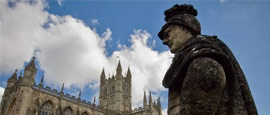The magnificent Abbey Church is the dominant edifice in Bath’s city centre. The construction of the abbey that stands today began in 1499, although its history can be traced back to the 7th Century. Visitors who brave the steep climb to the dome are rewarded with views of Bath and the surrounding countryside.
Things to see in Bath
Tourist offices
Address: Abbey Chambers, Abbey Church Yard, Bath, BA1 1LY, United Kingdom
Tel: +44 906 711 2000.
Opening Hours:Mon-Sat 0930-1730, Sun 1000-1600. www.visitbath.co.uk
Located plum in the city’s main tourist vortex, this is a convenient one-stop-shop for maps, information on sites, and assistance from friendly staff.
Pick up a Bath Visitor Card and enjoy three weeks of discounts across town – from meals and cocktails to city attractions. The card is available from the tourist information centre or online (www.visitbath.co.uk/special-offers/bath-visitor-card).
The zenith of Palladian architecture in Bath, the stately arc of the Royal Crescent was built to the designs of John Wood the Younger between 1767 and 1774. Recently completed, No. 1 Royal Crescent has been transformed into a furnished replica of how an 18th-century residence might have appeared on this illustrious address.
The Jane Austen Centre is a permanent exhibition devoted to Jane Austen and her relationship with Bath. The centre explores how her 1801-1806 residency affected her life and writing. Go the full Elizabeth Bennett and pay £10.50 to dress up and have your hair done Regency style. Book in advance.
The Roman Baths are the historical heart of Bath, tapping the hot springs that had prompted the Celts to create a shrine on the site of the future city over 2,000 years ago. The Romans, in turn, erected a significant temple and bathing complex that is one of the best-preserved Roman sites north of the Alps. July and August evenings offer a unique time to visit, when the complex is illuminated by torchlight.
When Thermae Bath Spa opened its doors in August 2006, it had been 28 years since the last person had bathed in Bath's natural thermal waters. This modern spa and bathing complex offers several pools, including an open-air pool on the roof). It prides itself on being a municipal spa and the prices are reasonable.
Explore fashion throughout the last 400 years at this charming museum housed within the Assembly Rooms. Displays of colourful costumes demonstrate historical and contemporary fashions, showing us what garments our ancestors considered the ‘in thing’, and how trends have evolved and endured through the ages.
A 10-minute walk from the city centre, this elegant sloping garden was created in the 18th century and designed by the poet Alexander Pope and Lancelot 'Capability' Brown. Set in a sweeping valley with superb views of the city, the garden features a Palladian bridge (complete with 18th-century graffiti), lakes and a gothic temple, among other romantic features.
Suitably housed in the architecturally striking Countess of Huntingdon’s Chapel, this small but perfectly formed museum offers an insight into how Bath transformed into one of the architectural wonders of modern Britain. Video presentations enlighten on the techniques that shaped Georgian Bath, while the scale model of the city is worth the entry fee alone.
Do you have any Feedback about this page?
© 2025 Columbus Travel Media Ltd. All rights reserved. No part of this site may be reproduced without our written permission, click here for information on Columbus Content Solutions.








 You know where
You know where